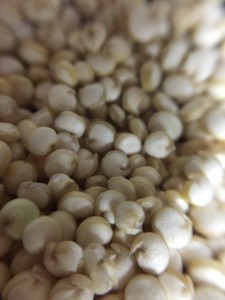Quinoa is the common name for Chenopodium quinoa of the flowering plant family Amaranthaceae. It is grown as a grain crop primarily for its edible seeds. It is a pseudocereal rather than a true cereal, due to it not being a grass. Quinoa is closely related to the edible plants beetroot, spinach, and amaranth (Amaranthus spp.), another pseudocereal which it closely resembles.
After harvest, the seeds are processed to remove the outer coating containing the bitter-tasting saponins. Generally, the seeds are cooked the same way as rice and can be used in a wide range of dishes. The leaves are sometimes eaten as a leaf vegetable, much like amaranth, but commercial availability of quinoa greens is limited.
When cooked, the nutrient composition is comparable to common cereals like wheat and rice, supplying a moderate amount of dietary fiber and minerals. The Food and Agriculture Organization of the United Nations declared 2013 to be the “International Year of Quinoa”.[3]
Quinoa originated in the Andean region of Peru, Bolivia, Ecuador, Colombia and Chile,[4] and was domesticated 3,000 to 4,000 years ago for human consumption in the Lake Titicaca basin of Peru and Bolivia, though archaeological evidence shows a non-domesticated association with pastoral herding 5,200 to 7,000 years ago.[5]
From Wikipedia.




